Friday 6th January 2017
It was with some trepidation that I had booked the ‘Black and Blue’ tour with Arctic Adventures, safe and warm in the comfort of my parents’ house in England. When the day rolled around however, waiting for my pick-up outside my hostel on the outskirts of Reykjavik, 9:00am, still in the pitch black (the sun does not rise until ~11am in early January in Iceland), a howling wind and snowing, I entertained the idea of spending a day poring over a book in a hygge-ish coffee shop in Reykjavik instead. But Arctic Adventure’s spiel had sold me – it had told of exploring Leiðarendi, a lava tube, learning of tales of the Icelandic elves, and then an afternoon spent snorkelling in Silfra, the fissure between the North American and Eurasian continental plates. The water would be around 2 degrees Celsius. I had been snorkelling before, mainly in Australia where the water was more like 25 degrees Celsius (but then the prospect of shark attacks did add an element of worry there, too). There were to be no sharks here. What there would be though, I hoped, was the promise of crystal clear water, and up to 100m visibility, even on a cloudy day.
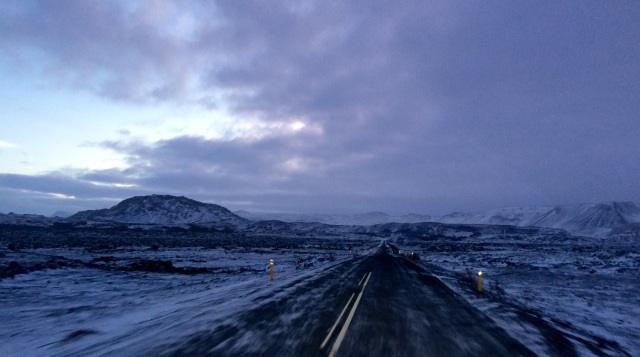
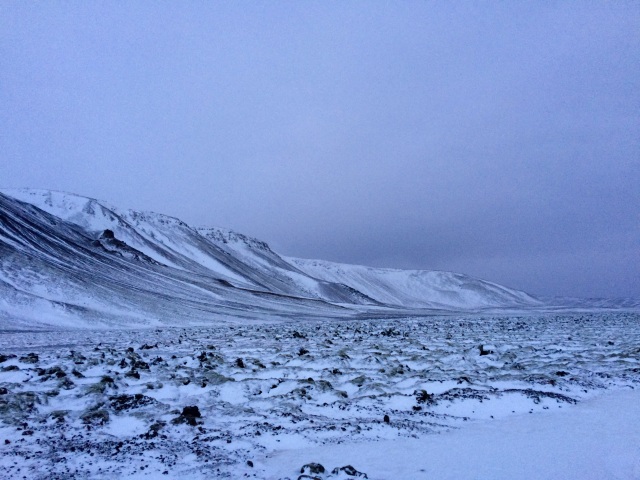
And so I was picked up with other already-cold-looking people and we set off, arriving at our location close to the Blue Mountains and one of the more recently discovered lava tubes in Iceland’s volcanic ground. Again I wondered what I had got myself into when we were handed hard helmets and crampons “in case the wet ice is slippery”. Oh. I have never worn crampons in my life, and as we peered down into the black opening in the snowy ground, I wondered if my mild claustrophobia would get in the way of what promised to be an adventure.
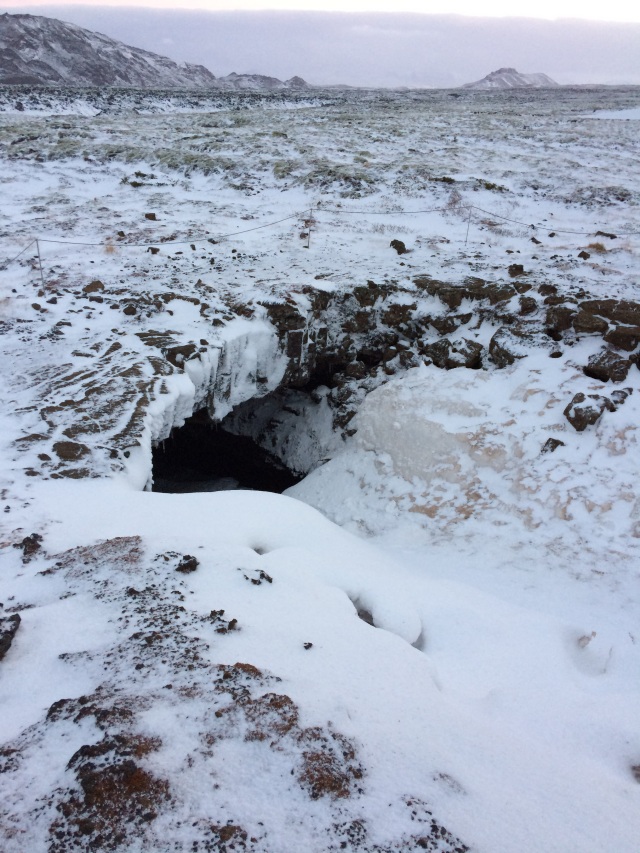
We shuffled slowly downwards, skidding and slipping on occasion, but were greeted by quite an open area where I could stand up (at 177cm) with just enough room so that my helmet did not scrape on the ceiling. The ceiling itself was adorned with dripping stalactites formed by slowly cooling lava, the ground with stalagmites (I had to google the difference…), a homage to the volcanic land we were admiring. As we made our way through the system, our guide Marteen talked us through the formation of the 900m circular lava tube. Later on, deep into the depths of the tube, we would discover the remains of a lamb, whose demise gave ‘Leiðarendi’ its name, English translation ‘The End of the Road’. Due to the conditions in the tube decomposition takes a long time. Only bacteria can survive, which glow white when light is shined on them.
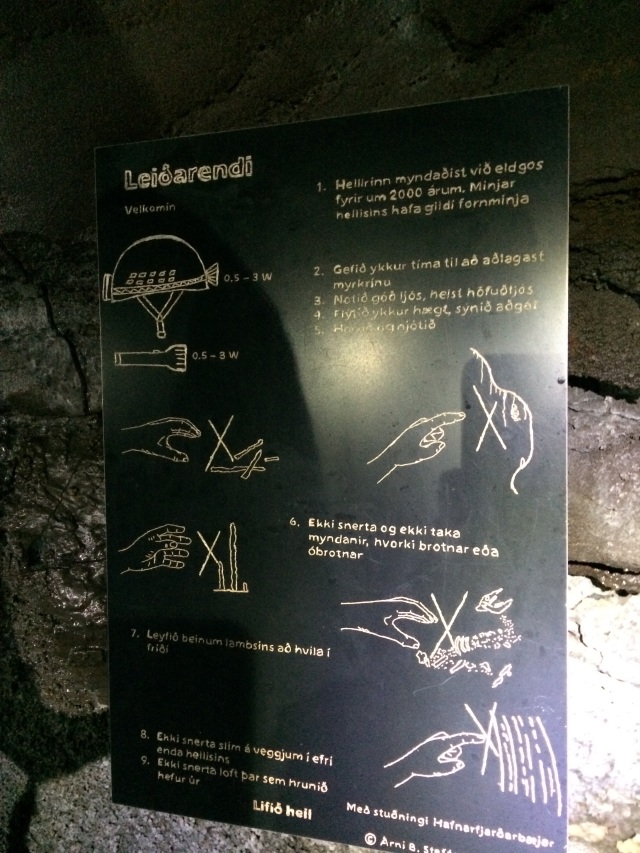
Pleasingly, although the narrowest section of the tube was low (perhaps just two feet of clearance from the ground), I was able to adopt a plank position (I hate planks) and shimmy through on my front, moving sideways like a crab. Although exciting, as my helmet scraped on the ceiling as I tried to periodically lift my head above the vertical to shine my head light on the direction I was shimmying, my hands negotiating the sharp ground, I had to take some deep breaths. After emerging on the other side, Marteen asked us if we wanted to experience ‘true darkness’. Of course! He had us sit down first (presumably this experiment could end in complete disorientation, loss of balance and potential tourist harm/liability claims?) before we all switched our head lamps off and sat quietly, the only noise the ‘drip drip’ of water from the stalactites. Marteen then told us of the discovery of the tube only around 20 years ago by a geology student who stumbled across its existence by accident and went in to explore with a torch. Deep within the tube he dropped his torch, it switched off, and he was plunged into darkness, much as we were. This is where the story differs: Version A is that the student simply found his torch after a bit of grappling around in the dark; version B is that an elf handed it back to him. The Icelanders do love their elvish folklore!
We followed the tube round and clambered out through the other exit, blinking in the daylight and bright white snow. After a service station stop, we headed off for Þingvellir National Park, a UNESCO World Heritage Site and location of Iceland’s, and the world’s first parliament. Also the location of Silfra, and our afternoon of snorkelling merriment. Check out my other blog post (Land of Fire and Ice: Viking Horses and The Golden Circle) where I visited the National Park itself.
We arrived at the parking area at the site as a mob of tourists who can only be described as looking like penguins waddled awkwardly across the road, wearing huge padded drysuits, complete with snorkels and flippers. Without being able to see any expanse of water, and the area being rocky and snowy, they looked most out of place. As did we half an hour later.
We got changed outside – we were lucky it wasn’t snowing. First we took off some layers so that we might be able to fit into the upcoming layers. We then climbed into drysuits, which resembled sleeping bags with arm and leg holes, then dubiously eyed the still-wet-from-their-previous-outing wetsuits that were handed to us, before helpful guides from Arctic Adventures sprinkled baby powder down the sleeves to make it easier to pull them on, although we still fell into hysterics every minute as we heaved and tugged at each other’s limbs. We were zipped in to our outfits; I was wearing so many layers, worried about freezing in the water, that I couldn’t lift my arms more than 90 degrees, and wondered how I would stay afloat…
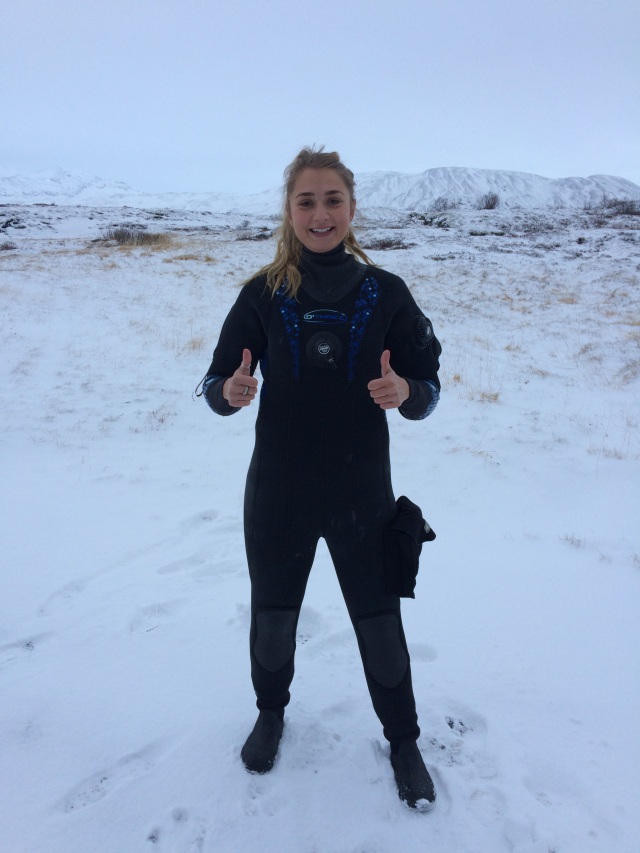
Next came a neck tube and an additional neck choker to help prevent leaks. “If it feels like you’re choking a little bit that’s good!” said one of the guides to me. Then came hoods, and finally wet gloves which instantly turned my hands to ice. Lastly came masks, snorkels and flippers. We looked so ridiculous and out of place that we could barely contain ourselves. We too then waddled the few hundred metres to the fissure where metal grates leading down into the black water greeted us. It was an overcast day and I couldn’t imagine how the water could still have good visibility, and in the words of Arctic Adventures’ description of the tour, the Silfra fissure “does not look like much on the surface.”
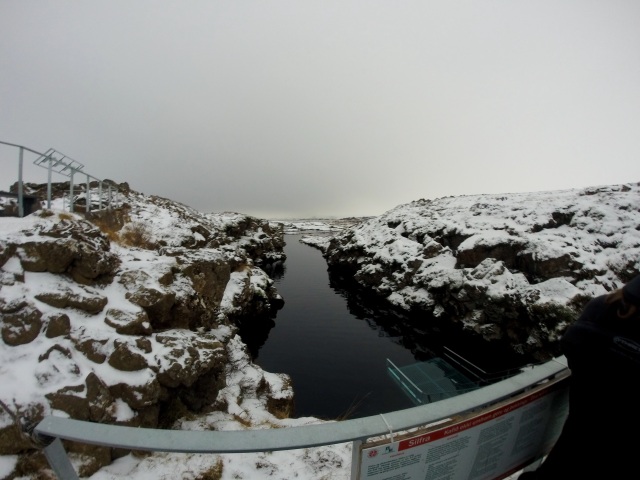
All of the guides for the snorkelling part of the tour are certified PADI diveguides/divemasters, and ours was particularly good with making sure we were completely sealed into our suits. Theoretically the only place the water should directly touch would be our faces – “but it will freeze instantly and so will not hurt!” We took it in turns to lie down ‘on’ the water to test our (hopefully) watertight seals and mask visibility, whereupon I found that 1) there is so much air in the drysuit that you literally float almost above the water, no effort required (that answered my question about keeping myself afloat); and 2) the water was, as promised, completely and utterly crystal clear. Despite the grey sky, rocky ground and seemingly black water from above, below the surface the water had perfect visibility, as if lit from the bottom, and I could see rock formations stretching below me.
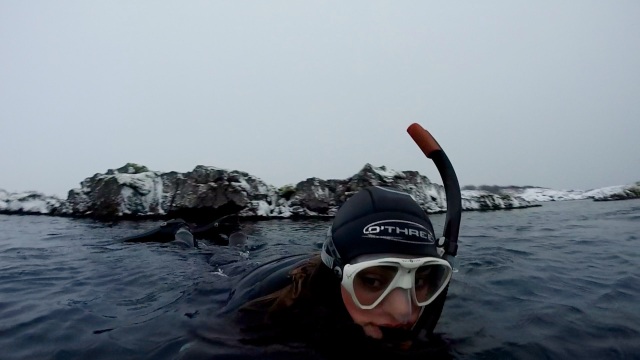
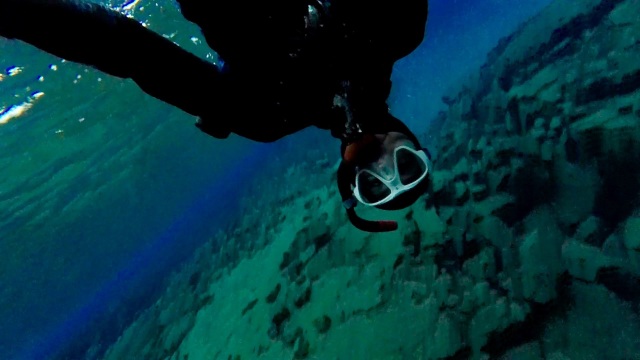
My face did indeed instantly freeze, but after the initial shock of having it immersed in such cold water, it felt fine. My hands, the only other parts of my body that were wet, initially froze but defrosted not too long after I started paddling a little. Not much paddling was required though: the water has a current as it travels from from the Langjökull glacier to the Þingvallavatn lake, the largest in Iceland, via the fissure. This journey through lava rock can take up to 100 years, hence the clarity of the water. We bobbed along, periodically paddling a little to steer ourselves through initially quite narrow sections. I was completely and utterly taken in by the view beneath us. When we got to a wider opening, our guide showed us drysuit newbies how to both roly-poly and sit upright in the water…a feat easier said than done with so much buoyancy. It takes a lot of effort to counteract the air in the suit and push underwater, but once in an upright sitting position in the water, the concept is the same as floating – absolutely zero effort is required to stay there!
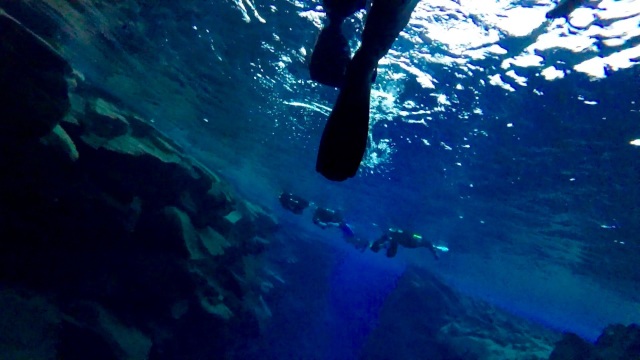
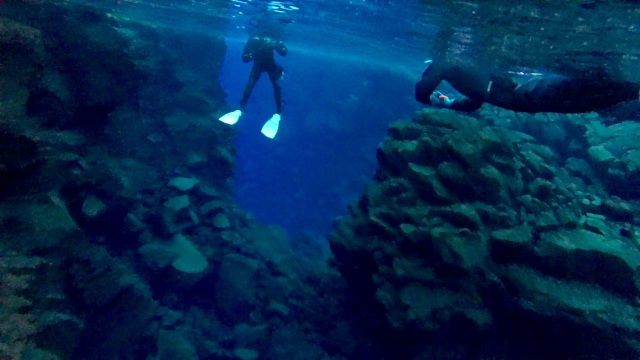
After clambering out of the water, surprisingly toasty after immersion for almost an hour, we were swiftly helped out of our attire and bundled back into the van. If you are even considering a trip to Iceland, I would put this tour at the top of your ‘to do’ list for a day of exploring the ‘black and blue’. After all, there is nowhere else in the world where you can snorkel or dive directly between two continental plates, particularly in the same day as exploring a lava tube.
https://adventures.is/iceland/day-tours/snorkeling-and-diving/black-and-blue/



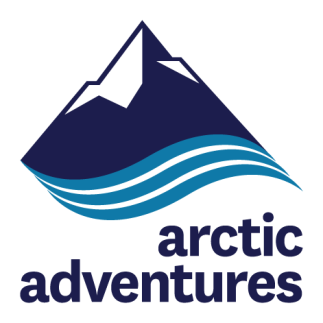
Your snaps are wonderful. 🙂
LikeLiked by 1 person
Thank you!
LikeLiked by 1 person
Woah!!! You seem so adventurous🏃
Amazing clicks!❤
LikeLiked by 1 person
Thank you! It’s just a rouse though, most of the time I’m at home watching Netflix…
LikeLiked by 1 person
Hahaha……😂😂😂
Btw I too love myself being a couch potato🙈🍟
LikeLiked by 1 person
Awesome pictures and travel content! Saw you post on Community Pool and came by to see what your blog was about, and Im glad I did!
LikeLiked by 1 person
Thank you very much. Iceland lends itself to cool photos!
LikeLiked by 1 person
I love your writing!! Finding a beautifully-written travel blog can be difficult, but you balance the thoughtful words with pictures from your experience masterfully. (Your pictures are gorgeous too, of course.)
LikeLiked by 1 person
Thank you so much Sydney!
LikeLike
Such a wonderful adventure you took us on!
LikeLiked by 1 person
Thank you Christy!
LikeLiked by 1 person
Oh my days! This too is being added to my bucket list – before the arthritis kicks in😂😂
LikeLiked by 1 person
Do it! I would have thought that you have a bit of time left before that..!
LikeLiked by 1 person
Beautiful and detailed write- up. Just what I want to see👍🏽👍🏽👍🏽
LikeLiked by 1 person
Thank you Vivian!
LikeLiked by 1 person
I like the two under water shots. I don’t anyone could pay me enough money to do the underwater bit.
LikeLiked by 1 person
I can hardly dip my feet in a cold river for more than a few seconds. Kudos on diving with a frozen body.
LikeLiked by 1 person
Thank you Stewie! Although I felt like a stuffed sausage due to all the layers so wasn’t too cold in the end 🙂
LikeLiked by 1 person